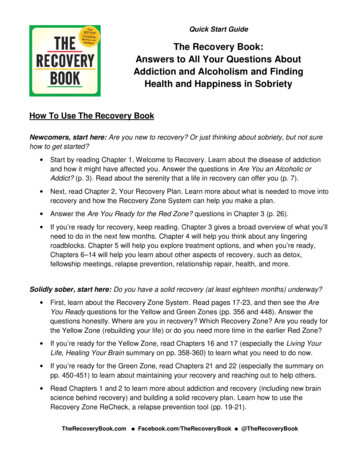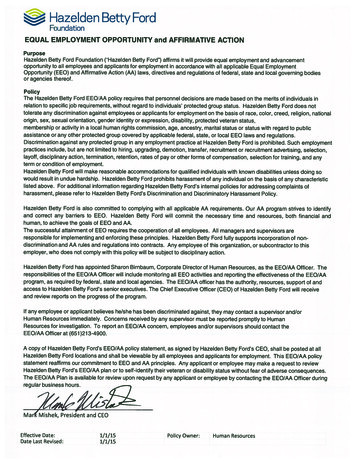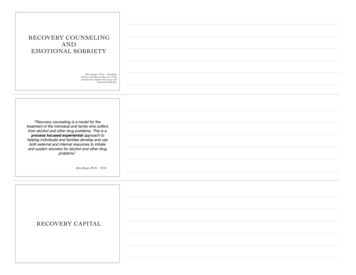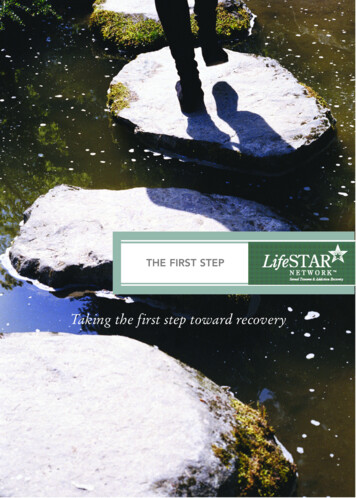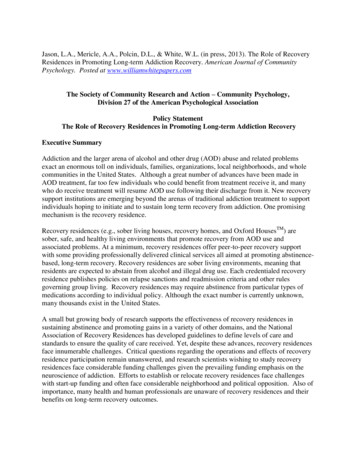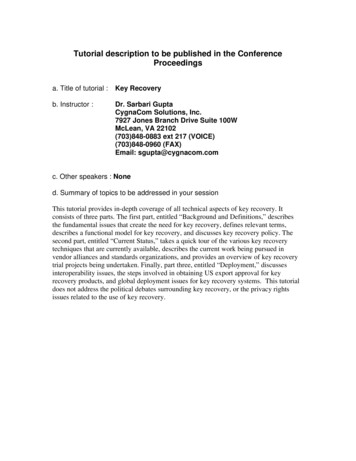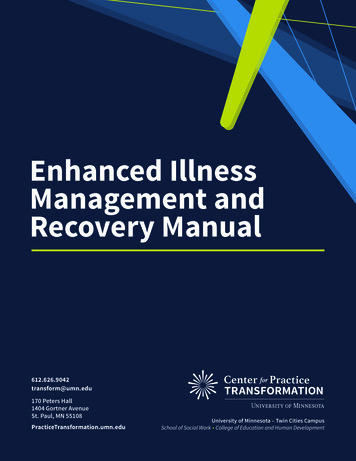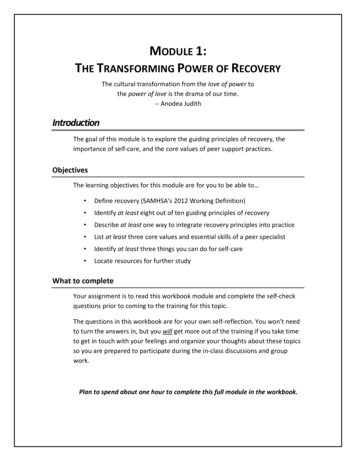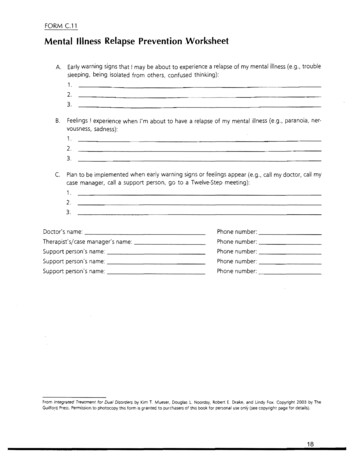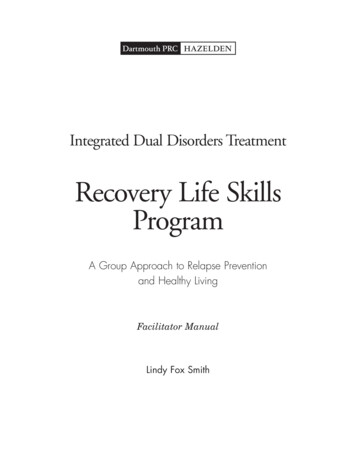
Transcription
Integrated Dual Disorders TreatmentRecovery Life SkillsProgramA Group Approach to Relapse Preventionand Healthy LivingFacilitator ManualLindy Fox Smith
Hazelden PublishingCenter City, Minnesota 55012hazelden.org/bookstore 2011 by DartmouthAll rights reserved. Published 2011Revised and updated for DSM-5 edition published in 2015Printed in the United States of AmericaUnless a statement on the page grants permission or permission has been obtainedfrom the publisher, no part of this publication may be reproduced, stored in aretrieval system, or transmitted in any form or by any means—electronic, mechanical,photocopying, recording, scanning, or otherwise—without the express written permission of the publisher. Failure to comply with these terms may expose you to legalaction and damages for copyright infringement.ISBN: 978-1-61649-644-9Passages from Integrated Dual Disorders Treatment (IDDT): Best Practices, Skills,and Resources for Successful Client Care (Center, City, MN: Hazelden, 2010) arereproduced with the permission of the publisher.The Weiss AAA Method and mnemonic appear with permission from Roger D. Weissand Hilary Smith Connery. Originally published in Integrated Group Therapy forBipolar Disorder and Substance Abuse (New York: Guilford Press, 2011).20 19 18 17 16 151 2 3 4 5 6 7Cover design by Terri KinneInterior design and typesetting by Madeline Berglund
The Dartmouth PRC–Hazelden imprint was formed as a partnership between theDartmouth Psychiatric Research Center (PRC) and Hazelden Publishing, a divisionof the Hazelden Betty Ford Foundation—nonprofit leaders in the research anddevelopment of evidence-based resources for behavioral health.Our mission is to create and publish a comprehensive, state-of-the-art line ofprofessional resources—including curricula, books, multimedia tools, and staffdevelopment training materials—to serve professionals treating people with mentalhealth, addiction, and co-occurring disorders at every point along the continuumof care.For more information about Dartmouth PRC–Hazelden and our collection ofprofessional products, visit the Hazelden Behavioral Health Evolution website atwww.bhevolution.org.Duplicating this page is illegal. Do not copy this material without written permission from the publisher.iii
This manual is dedicatedto all the peoplewith co-occurring disorderswho have shared their recovery with me.I have learned so much from all of you.Thank you for sharinga part of your journey with me.Duplicating this page is illegal. Do not copy this material without written permission from the publisher.v
CONTENTSAcknowledgmentsIntroduction.ix.1.17.27A Key to the Session OutlinesSession ChecklistsSession Outlines.31.43Session 1: Orientation and Working on GoalsSession 2: Recovery and Goal IdentificationSession 3: Preventing Relapse I: Triggers for Substance Use.51.61Session 5: Coping with Negative Feelings I.69Session 6: Coping with Negative Feelings II.83Session 4: Preventing Relapse II: Early Warning Signs of Mental Health DisordersSession 7: Developing Leisure and Recreational Activities.Session 8: Dealing with Social Situations Where Alcohol and Drugs Are OfferedSession 9: Open TopicSession 11: Relationship Skills. . . . . . . . . . . . . . . . . . . . . . . . . . . . . . . . . . . . . . . . . . . . . . . . . . . 125. . . . . . . . . . . . . . . . . . . . . . . . . . . . . . . . . . . . . . . . . . . . . . . . . . . . . . . . . . . . . . . 133Session 12: Communication Skills. . . . . . . . . . . . . . . . . . . . . . . . . . . . . . . . . . . . . . . . . . . . . . . . . . . . . . . . . . . 141Session 13: Peer Recovery Support Groups. . . . . . . . . . . . . . . . . . . . . . . . . . . . . . . . . . . . . . . . . . . . . . . . . 151. . . . . . . . . . . . . . . . . . . . . . . . . . . . . . . . . . . . . . . . . . . . . . . . . . . . . . . . . . . . . . . . . . . . . . . 165Session 15: Spirituality and Inner Peace. . . . . . . . . . . . . . . . . . . . . . . . . . . . . . . . . . . . . . . . . . . . . . . . . . . . . 173Session 16: Developing a Positive Self-ImageSession 17: Healthy Lifestyles. . . . . . . . . . . . . . . . . . . . . . . . . . . . . . . . . . . . . . . . . . . . . . . 185. . . . . . . . . . . . . . . . . . . . . . . . . . . . . . . . . . . . . . . . . . . . . . . . . . . . . . . . . . . . . . . 193Session 18: Review Personal Recovery PlanReferences. . . . . . . . . . . 105. . . . . . . . . . . . . . . . . . . . . . . . . . . . . . . . . . . . . . . . . . . . . . . . . . . . . . . . . . . . . . . . . . . . . . . 117Session 10: Developing a Social NetworkSession 14 Open Topic95. . . . . . . . . . . . . . . . . . . . . . . . . . . . . . . . . . . . . . . . . . . . . . . . 205. . . . . . . . . . . . . . . . . . . . . . . . . . . . . . . . . . . . . . . . . . . . . . . . . . . . . . . . . . . . . . . . . . . . . . . . . . . . . . . . . . . . . . . . 209Thumbnail Views of IDDT Recovery Life Skills Program HandoutsAbout the Author. . . . . . . . . . . . . . . . . . . . . . . . . . . . . . . 211. . . . . . . . . . . . . . . . . . . . . . . . . . . . . . . . . . . . . . . . . . . . . . . . . . . . . . . . . . . . . . . . . . . . . . . . . . . . . . . . . . 227Duplicating this page is illegal. Do not copy this material without written permission from the publisher.vii
sACKNOWLEDGMENTSI would like to acknowledge all the facilitators and group members at my pilotsites. Without their help in piloting and giving me feedback in the Recovery LifeSkills Program Group curriculum, it would not be as complete and comprehensivea program as it now appears.Listed below are the original pilot sites:Community Connections, Washington, D.C.Alcohol Drug Recovery Centers, Hartford, CTBirmingham Group Health Services, Ansonia, CTCapitol Region Mental Health Center, Hartford, CTConnecticut Renaissance, Waterbury, CTRegional Network of Programs, Bridgeport, CTSouthwest Connecticut Mental Health, Bridgeport, CTMental Health Center of Greater Manchester, Manchester, NHI would also like to acknowledge my first two facilitators in Washington, D.C.,Chad Holm and Roxanne Talbott, as well as all the other Community Connectionsstaff who helped me develop the first group and offered ideas and support to theoriginal group manual. Thanks also to my pilot site coordinators: Julienne Giard,who is the manager of EBPs in the Connecticut Department of Mental Health andAddiction Services, and Diane Distaso, a coordinator of outpatient services at theMental Health Center in Manchester, New Hampshire. Without their help andcoordinating abilities the pilots would not have happened!Thanks, of course, to all my Dartmouth colleagues who continue to support me inevery way. Special recognition goes to Glenda Madden, who typed many versions ofthis manual and never complained. I still owe you dinner! Along with my Dartmouthcolleagues, I wish to acknowledge the amazing support and hard work of the Hazeldenteam. It has been a real joy and honor to work with you on this project, and a specialacknowledgement to Pat Boland, my editor, who worked tirelessly on the early draftsof the manual. I really appreciated all your hours of revisions after I changed things!Lastly, thanks to my husband, Paul, whose friendship and love sustain methroughout all the work I do. Duplicating this page is illegal. Do not copy this material without written permission from the publisher.ix
sINTRODUCTIONThe Integrated Dual Disorders Treatment (IDDT) Recovery Life Skills Program is agroup counseling program for people with dual, or co-occurring, disorders who are inactive treatment or the relapse prevention stage of treatment. This manual is designedto help you, the practitioner, work with group members who have severe mentaldisorders and addiction—whether you are newly treating people with co-occurringdisorders, have an established co-occurring disorders program, or are anywherealong that continuum.Group interventions are the most effective treatments we have to help peoplewith co-occurring disorders. The Recovery Life Skills Program incorporates severalevidence-based approaches including psycho-education, social skills training, andcognitive-behavioral techniques.This program was piloted at several sites, both urban and rural, inpatient andoutpatient, and was well received by the group members. Members reported thatthey liked the group and being with peers who were similar to them. Sometimesthe measure of a group such as this is whether or not the members enjoy it, findit useful to their recovery, and keep coming back. That was the feedback receivedfrom the pilot groups, with several sites having waiting lists of potential memberswanting to join.About Co-occurring DisordersThe term co-occurring disorders generally refers to a co-existing mental health disorder and substance use disorder. Co-occurring disorders is more often used todayinstead of the term dual disorders, which is restricted by use of the word dual,meaning “two.” Co-occurring disorders may refer to people who have one or moremental health disorders coupled with one or more substance use disorders.The Need for Integrated TreatmentFor about three decades, the mental health field has recognized the prevalence ofsubstance use disorders among people with a severe mental disorder such as schizophrenia, bipolar disorder, and major depressive disorder. About half of all adults withsevere mental health disorers also have a substance use disorder at some time inDuplicating this page is illegal. Do not copy this material without written permission from the publisher.1
INTRODUCTIONtheir lives. The rates are higher for people in acute caresettings (such as emergency rooms and psychiatrichospitals), those involved in the criminal justice system,or people who are homeless.During this time the mental health field has alsocome to recognize that parallel or sequential treatmentapproaches to these problems are ineffective. For example,treating mental health and substance use disorders separately, either one at atime (sequential) or in separate settings (parallel), never really made sense,since these disorders are experienced together. Indeed, people striving to recover from co-occurring disorders experience mental disorders and substance usedisorders as intertwined, interacting, and relatively inseparable. They oftenexperience psychiatric symptoms and substance use at the same time or inclose proximity, and relapses often involve both problems.Integrated Dual Disorders Treatment is an evidence-based practice wherea clinician, or team of clinicians, treat a person’s mental disorder and substanceuse disorder at the same time. The integrated treatment model addresses theproblem of access by ensuring that one visit, in one setting, is sufficient toreceive treatment for both disorders. It addresses the problem of combiningmessages and philosophies by giving this responsibility clearly to the treatmentprovider instead of the client. One of the key features of Integrated DualDisorders Treatment is motivation-based or stage-wise treatment.Stages of Change and the Stages of Treatment ModelFor years, researchers have proposed that people make behavioral changes instages, moving from unawareness or pre-contemplation to contemplation ofchange, then from action to maintenance of change. This approach—the stagesof change model developed by James Prochaska and Carlo DiClemente—canbe useful when creating treatment plans for people who have a substance usedisorder. Pinpointing where people are in the stages of change process can helpclinicians determine what interventions might be the most beneficial as theperson being treated moves forward.In a similar vein, identifying where people are in their stage of treatmenthelps clinicians work with them on developing goals to pursue and determiningwhich interventions to try. The stages of treatment model, while similar to thestages of change model, is specific to co-occurring disorders; it is an interventionbased approach that occurs within the context of the therapeutic relationship.2Duplicating this page is illegal. Do not copy this material without written permission from the publisher.
INTRODUCTIONThe stages of treatment model includes four stages: engagement, persuasion,active treatment, and relapse prevention.The table below compares the two models.STAGES OF CHANGEPre-contemplationSTAGES OF ionActionActive treatmentMaintenanceRelapse preventionTo effectively address a person’s co-occurring disorders, treatment musttarget the person’s stage of change, or motivation for recovery. Specific interventions are most effective at the appropriate stage of treatment.In the first stage of treatment, engagement, the clinician’s goal is to developa trusting relationship with clients, who are often avoiding treatment. Thismeans clinicians have to reach out to clients in the community through practicalstrategies such as helping them get benefits, food, clothing, housing, or jobs, orhelping them reconnect with their families. These strategies help the personstabilize and become motivated for recovery.Once a relationship has developed, the clinician tries to help the client developa positive view of the future. This is known as the persuasion stage. Persuasiontypically involves the clients recognizing that substance use is interfering withtheir mental health and diminishing their quality of life. Motivational strategiesare key at this point. With the help of clinical support, clients identify importantgoals to work on and begin to move forward with that work.Once they have reached the active treatment stage, clients have decided tocut back or end their substance use, and they actively work to reduce use andbecome abstinent. Several interventions are commonly used during this stage,including cognitive behavioral therapy group workDuplicating this page is illegal. Do not copy this material without written permission from the publisher.3
INTRODUCTION peer support in the community alcohol or drug refusal skill buildingOnce a person has been abstinent or without problems related to substanceuse for six months, the relapse prevention stage begins. This stage focuses onmaintaining these gains in sobriety. Clients also focus on managing their mentaldisorder symptoms and on improving their overall quality of life. The tasks inrelapse prevention are to develop a relapse plan continue group work continue with peer-support practices work on quality-of-life issues (such as work, recreation, and wellness)The Recovery Life Skills Program is specifically designed for people with cooccurring disorders who are in the active treatment stage or relapse preventionstage of treatment. This program is tailored to support people who have eitherachieved abstinence or made a commitment to work toward abstinence.Theoretical Framework of the ProgramEducational, motivational, and substance use disorder treatment and cognitivebehavior therapy (CBT) techniques form the foundation of this program. Theprogram builds on the approach to integrated treatment that is described inIntegrated Treatment for Dual Disorders (IDDT): Best Practices, Skills, andResources for Successful Client Care (2010). Although group facilitators andclinicians using the Recovery Life Skills Program do not need to be experts onthe IDDT manual, those who want to learn more about the evidence-basedtechniques used in this group may wish to read that manual. For more information on IDDT, please visit hazelden.org/bookstore.Motivational Interviewing TechniquesOne of the ways motivational interviewing is used in the program is by helpinggroup members set goals and break their large goals into short-term, smallergoals. Facilitators also use the following motivational interviewing techniques:asking open-ended questions, using affirmations, and practicing reflective listening. Summarizing is also a helpful technique that is incorporated into this program. In each session, you will see suggestions for when to wrap up a discussionor when to link information from one discussion to another. All of these motivational interviewing techniques come together as you help group members worktoward their short- and long-term goals.4Duplicating this page is illegal. Do not copy this material without written permission from the publisher.
INTRODUCTIONCognitive Behavioral TherapySimply providing group members with information about their disorders will nothelp them learn the skills needed to make life changes. But the behavioraltherapy known as cognitive behavioral therapy (CBT) can help members learnthese skills. CBT helps people learn how to set and work toward goals to findthe quality of life they want. Most mental health practitioners are alreadyfamiliar with CBT, and many counselors use CBT without even realizing it. Forexample, they give reinforcement all the time with praise, encouragement, or asmile—each of which is a part of the practice of CBT.Here are some of the CBT techniques used in the Recovery Life SkillsProgram: Relapse prevention skills help group members identify triggers and high-risk situations and develop a relapse plan. Role-playing involves demonstrating, or modeling, the new skill or behaviorfor group members; having them practice the behavior in the role-playingexercises; and shaping and reinforcing these skills. Coping skills help manage symptoms and cravings. Cognitive restructuring helps group members challenge negative thoughtsassociated with depression, anxiety, trauma, and substance use. Social skills training gives group members practice in dealing with high-stress situations without triggering a relapse. It also helps them buildsupportive relationships.Substance Use Disorder CounselingThis group makes use of techniques and practices found in substance use disorder counseling. Most group members should be familiar with peer recoverysupport groups. In this group, they will learn more about these peer supportgroups, and they will revisit the Twelve Steps. Group members will considerthe role of spirituality in their lives.Psycho-educationThe group member handouts in this program are designed to provide basicinformation for both group members and facilitators. They are written in asimple, everyday language for ease of reading and comprehension. You canbegin each session by reviewing the content of the handout. You might sharethe title of the topic and read the first few sentences, then ask open-endedquestions to assess the group’s knowledge of the topic.Duplicating this page is illegal. Do not copy this material without written permission from the publisher.5
INTRODUCTIONLearning is meant to be an interactive process. Sometimes you may wantto read part of a handout to the group, and other times you may wish to conveyinformation to group members. Group members may also want to take turnsreading a particular handout. At other times, they may just want to discussit. Remember to always be sensitive to members who might not be able to reador write. During the pre-group interview, ask potential members how they feelabout reading and writing tasks. If some of your group members struggle withreading or writing, discuss how they want to handle the situation when theyneed to fill out a worksheet. They might want a facilitator to help them or theymay want to work with someone in their group.This facilitator guide includes suggestions for when to check for understanding and when to review information with the group. Additionally, thesection on literacy (toward the end of this introduction) offers suggestions fortalking about reading and writing skills with potential group members.The Benefits of Working in a GroupOne of the best ways to treat people with substance use disorders is in groups,which makes sense since people also tend to use substances in groups. Havingpeers in a group who struggle with the same problems helps group membersfeel they are not alone in their battle with addiction. The peer role modelingand peer support in these groups can be powerful and effective.The members of an active treatment or relapse prevention group, such asthe Recovery Life Skills Program, are all working on reducing substance use orbecoming abstinent. As a result, members tend to be highly motivated to participate in the group and work on their recovery skills. This level of motivationalso means that facilitators do not usually need strategies to promote attendance.6Duplicating this page is illegal. Do not copy this material without written permission from the publisher.
INTRODUCTIONAnother benefit of group work is that members help each other achievetheir recovery goals. Peers often confront each other about their intentions andbehaviors. When someone in the group has a slip, or briefly returns to substanceuse, for example, other members of the group might call the person out, askabout the use, and question what he or she is doing about it.As the facilitator in the group, you can monitor such interactions so they donot become emotionally charged and so that the atmosphere remains supportiveof the group member who had the slip. (In terms of therapeutic style, an activetreatment group will tolerate a higher level of confrontation than will be permitted by a persuasion group.)The Goal of the Recovery Life Skills ProgramA person’s ability to maintain stability in the active treatment and relapseprevention stages of treatment is directly connected to the ability to achieve asatisfying quality of life. Helping and supporting group members as they practicenew behaviors that will enhance their daily lives is one of the overarching goalsof this program. This focus on quality of life will be present in each session andis at the core of the design and tone of the Recovery Life Skills Program.People attending this group will find that it is different from other relapsegroups. Although the topics may sound very traditional, each one is designedto address the unique needs of people in this stage of recovery from substanceuse who are now ready to get on with living their lives. This means, for instance,that instead of only developing a sober peer group (which should have alreadybeen accomplished by this stage), group members work on developing a socialnetwork. Group members will learn substance-refusal skills and skills to developclose, intimate relationships.How to Use the Recovery Life Skills Program MaterialsThe MaterialsThe Recovery Life Skills Program materials consist of this facilitator manualand a CD-ROM. Use the materials in any way that fits your teaching style. TheCD-ROM includes PDFs of all the session handouts and worksheets as well asthe group facilitator records and materials. You will need Adobe Acrobat orAdobe Reader to open the PDFs on the CD-ROM. Group facilitators can printthe handouts they need from the CD-ROM. The handouts are organized by thesession where they are used. "Thumbnail" views of each handout are includedat the back of this manual.Duplicating this page is illegal. Do not copy this material without written permission from the publisher.7
INTRODUCTIONTip: XYou may find it convenient to project the handouts for a particular session on a screen and refer to the visual images asyou discuss the topic with the group.Session FormatEach of the eighteen sessions includes the following five steps:q Step 1: Welcome and Check-Inw Step 2: Review of Previous Sessione Step 3: Topic Discussionr Step 4: Personal Recovery Plan Worksheet and Goalst Step 5: Home AssignmentA Key to the Session Outlines (found in this manual and also repeated as adocument on the CD-ROM), along with the individual session outlines in thismanual, provides detailed information on guiding a group through each ofthese five steps.Each session covers a topic in recovery. Sessions 9 and 14 are open topics.During these group sessions, members can raise topics they are interested indiscussing or return to issues that have already been covered in the group. Youshould alert group members a session or two before the open topic groups sothey can consider which topics they might like to discuss. If members do nothave a topic for these group sessions, three alternative topics are listed forgroups to choose from.Length of SessionsThe sessions are designed to be delivered in a 1-hour group session or over two1-hour sessions held consecutively. If you choose to extend one or more topicsinto two sessions, recommendations for how to do this are noted in A Key to theSession Outlines as well as in the Session Checklists section. A Key to theSession Outlines also provides time estimates for conducting each step of thesession. Keep in mind that these are ballpark estimates to help you plan, not8Duplicating this page is illegal. Do not copy this material without written permission from the publisher.
INTRODUCTIONtimes fixed in stone. Your facility may conduct sessions that are 90 minutes long,or only 45 minutes. Programs that have less than 1 hour for their group mayfind it difficult to cover the topic in one session—that is why we have designedthe program so that you can extend each topic from one session into two sessions.Flexibility is crucial. You should approach each session with a focus on listening to the needs and wants of the group. The program will not suffer if youextend a session or if you take additional time on a step.The sessions are intended to be delivered sequentially. At the end of theeighteen sessions, group members are given the opportunity to repeat thecurriculum. Many people find that because so much material is covered, theywould like to go over it one more time.Meeting LogisticsWhere and when you hold the group can be a particularly important detail forpotential group members. By this stage of recovery, people often have otherimportant time commitments, such as work and family obligations. Settinggroup times that are late in the day or in the evening is one way to supportpeople who are trying to move forward with their lives while strengtheningtheir recovery. In an outpatient setting, groups typically meet weekly for fourto six months. In an inpatient or residential setting where groups may be heldmore frequently, the curriculum may be completed within a month.How to Form a GroupForming and facilitating a co-occurring disorders group takes planning and,above all, organizational commitment to make the group work. Organizationshosting the groups will need to find, and sometimes train, skilled facilitators;set aside the time needed to both plan for and conduct groups; and find spaceand any other needed material resources.Duplicating this page is illegal. Do not copy this material without written permission from the publisher.9
INTRODUCTIONChoosing FacilitatorsExperienceFacilitators of the Recovery Life Skills Program can be relatively new to workingwith people with co-occurring disorders, but they should be knowledgeableabout co-occurring disorders, substance abuse counseling, and peer recoverysupport groups. Group facilitators need to be warm and friendly but also ableto set healthy, firm boundaries. They need to be skilled in group facilitation,motivational interviewing, and social skills training.CommunicationFacilitators are also responsible for keeping the treatment team informed ofmembers’ progress in the group. This communication can include giving thetreatment team an overview of the group curriculum and its goals before thegroup starts, and updating the team at regular treatment team meetings.When treatment team members know what topics their clients are workingon in the group, they are in a better position to help them. They can help reviewhandouts, help with home assignments and work on goals, offer support andencouragement, or all of the above. By coordinating with the treatment team,you can help group members get the most out of the group.Co-facilitatorsThe Recovery Life Skills Program group can also be co-facilitated. Many of thetopics are skills-based and are enhanced by role-plays. It is always helpful inthese situations to have co-facilitators do the role-play first—and demonstratewhat works, what skills were used, what did not work, and why. Pairing a moreinexperienced facilitator with a seasoned group leader to co-facilitate the groupcan also be a great training opportunity for the new facilitator.Having co-facilitators also becomes an advantage when one facilitatorneeds to leave the group for any reason. Losing a group facilitator can be verydisruptive to a group process. If, however, only one of two facilitators leaves thegroup, members do not feel the change as dramatically as they might if theyhad to begin with a completely new facilitator. Of course, many programs do nothave the staff to co-facilitate groups. Having two group leaders is not necessary,just desirable.Group Member EligibilityThe Recovery Life Skills Program is a group for people with co-occurringdisorders in the active treatment or relapse prevention stage. People who are10Duplicating this page is illegal. Do not copy this material without written permission from the publisher.
INTRODUCTIONstill actively using or who have never used substances are not appropriate forthis group. The ideal group member is someone who has made a commitmentto sobriety and wants to learn some new life skills and set so
disorders and addiction—whether you are newly treating people with co-occurring disorders, have an established co-occurring disorders program, or are anywhere along that continuum. Group interventions are the most effective treatments we have to help people with co-occurring disorders. The Recovery Life Skills Program incorporates several
